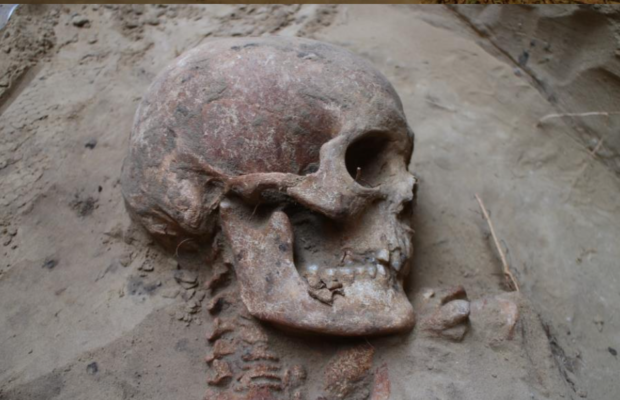The burial site was discovered by the archeological expedition of the Khortytsia National Reserve, headed by Dmytro Nykonenko, Candidate of Historical Sciences and leading researcher at the Department of Protection of Historical, Archaeological and Natural Monuments.
The entrance to the three-meter-deep catacomb was buried under a large number of heavy granite boulders. The archeologists explain that this was done in order to protect the burial site from robbers and gravediggers.

By the standards of his time, the warrior was a very tall man measuring just over 1.8 metres, and was obviously an archer. On average, Scythians measured not more than 1.6 metres. Archaeologists also found an iron knife with a bone handle, the remains of a quiver with bronze arrows and sacrificial foods (sheep bones).
“Our team from the Khortytsia National Reserve has been working in the Scythian cemetery for two months. We’ve uncovered this unspoiled burial site. This is a very rare find! The warrior was about 35-40 years old. His teeth are in perfect condition and he’s extremely tall. He was definitely not a farmer, but a Scythian warrior!” – said the leader head of the expedition Dmytro Nykonenko.
A closer study of the warrior’s pelvic bones revealed that he had probably spent most of his time on horseback. Moreover, according to Dmytro Nykonenko, he was no ordinary person, as great care had been taken to bury him in such a deep grave.

A cromlech was arranged over the burial place. This is a megalithic construction made of large stone blocks symbolizing the sun. Such stone constructions were very common among the ancient peoples.
“The burial site was quite deep. The depth of the pit is 3 metres. It was not easy to build. I can describe it as a catacomb, that is, first they dug an entrance pit, then made a niche – an underground chamber – where the deceased was placed. The entrance to the pit was laid with large rocks. We usually find one or two boulders, but here we discovered a large number of rocks, some of which weigh more than 200 kg.” added Nykonenko.
According to Maksym Ostapenko, director of the Khortytsia National Reserve, in 1995 he and his team found the burial place of a Scythian woman with a mirror, a necklace and a cantharus (large two-handled drinking vessel). All of these objects came from Egypt.
Archaeologists say that such finds indicate that the island of Khortytsia was an important Scythian settlement, a large trading centre visited by foreign traders, namely Greek merchants.
“Such finds indicate that in Scythian times Khortytsia was a relatively densely populated settlement. It was an important trading post as merchants and nomadic tribes could cross from one bank of the Dnipro River to the other. So, the people who lived here controlled and ensured the crossing of the river. This means that Khortytsia was a very important, strategic place at that time,” concluded Nykonenko.
[googlemaps https://www.google.com/maps/embed?pb=!1m18!1m12!1m3!1d85690.3649144492!2d35.00480385120681!3d47.84300475684777!2m3!1f0!2f0!3f0!3m2!1i1024!2i768!4f13.1!3m3!1m2!1s0x40dc66b321aefab1%3A0x6710540e258bdd14!2sNational%20Reserve%20Khortytsia!5e0!3m2!1sen!2sus!4v1628370336130!5m2!1sen!2sus&w=600&h=450]
Read More:
- Sensational archaeological find uncovers “Ukrainian Stonehenge” in eastern Ukraine
- Remarkable find near Khortytsia. Underwater archaeologists raise ancient Cossack gun carriage to surface
- Archaeologists discover Scythian treasure in Poltava Oblast
- Gilded Scythian sword found on Mount Mamai in Zaporizhzhia Oblast
- Sensational find on Khortytsia reveals the remains of an 18th century Cossack encampment
- Hoard of 1000-year-old silver coins with Ukrainian trident found in north Ukraine
- Treasures stolen from Kyiv cathedrals in the 1930s discovered in State Historical Museum in Moscow
- Remnants of a 12th century unique medieval fortification wall discovered in Kyiv
- Sensational find in Khortytsia as archeological team uncovers deep grave of Scythian warrior
- 900-year-old relic found under church floor in Busk, Lviv Oblast
- New dig in Chyhyryn sheds light on a page of Ukrainian Cossack history
- Egyptian mummies found in Kyiv Cathedral
- Stolen ancient viking’s sword from the dawn of Kyivan Rus comes back home to Ukraine








